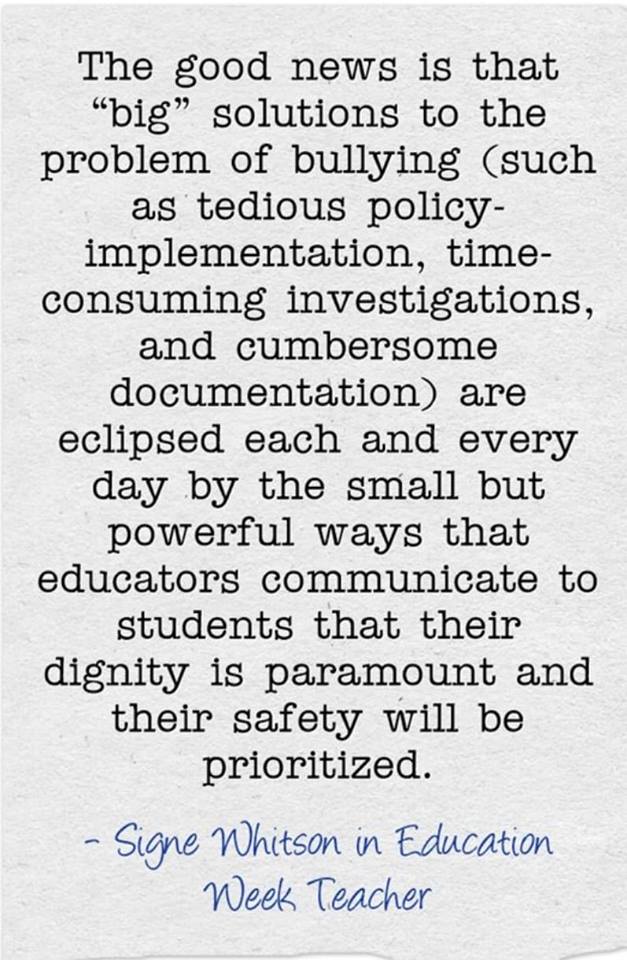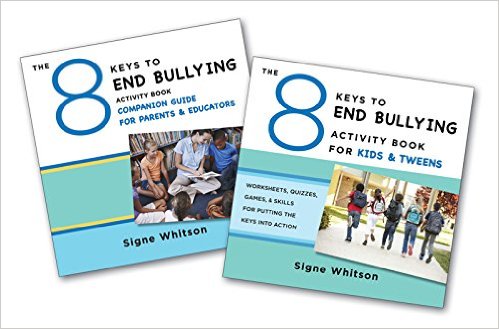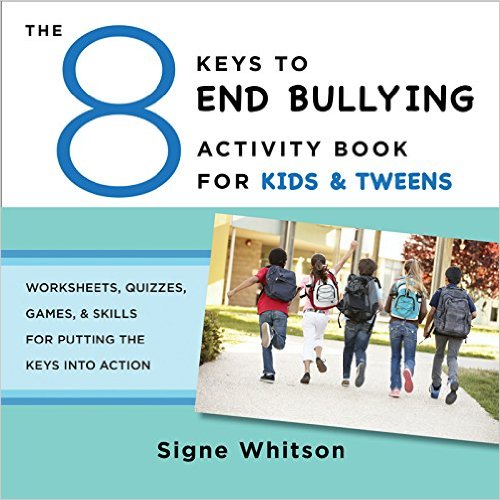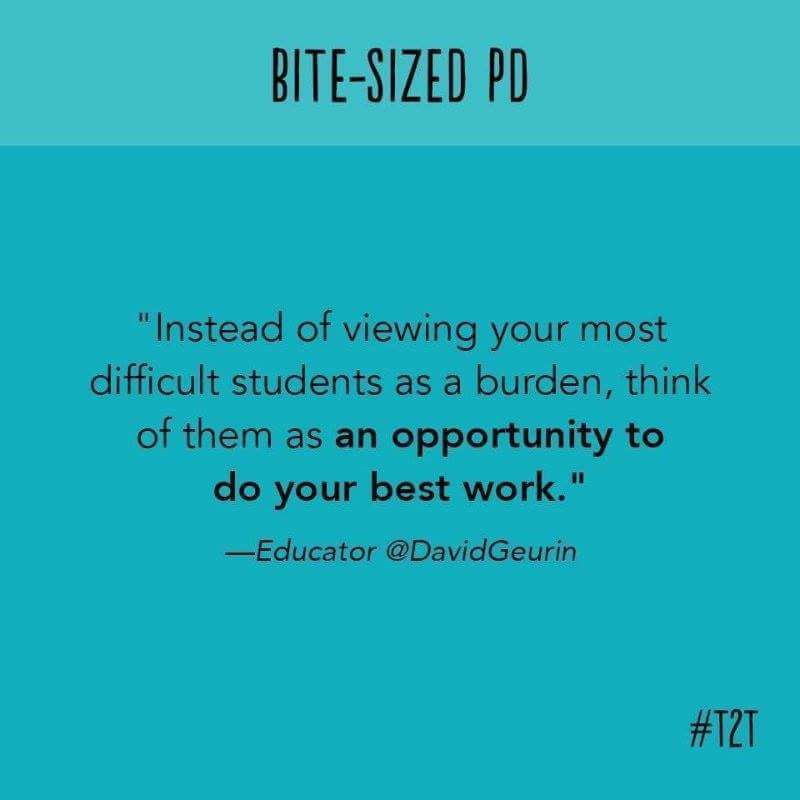Posts tagged bullying prevention
Bullying Prevention Grant for Teachers
0Study.com is offering a new funding opportunity to help teachers with bullying prevention.
The Study.com Grant offers $1,000 to two teachers each year to spend on resources and materials they need to promote safe, positive relationships among students. Specifically:
- $1,000 to spend on training, curriculum materials, or other resources to support bullying prevention, and
- a 12-month subscription to Study.com’s videos, worksheets, lesson plans, and more.
Full details can be found on the Study.com Grant for Teachers here.
Applications are accepted on a rolling basis. The first application deadline is March 1, 2019, and the second deadline is December 1, 2019.
Is it Rude, Is it Mean, or Is It Bullying?
0Originally written in 2012, in response to a real-life encounter with a worried parent, my article on Is it Rude, Is it Mean or Is it Bullying? is one of my most-read posts and has resonated with parents, professionals, and kids alike, who share the common experience of struggling for how to properly define unwanted behavior without catastrophizing the event(s).
From this original post, I have had the opportunity to speak with audiences all over the United States through workshops and trainings and to consult with administrators and educators on best practices in managing bullying in schools. Here are a few of the resources now available to help bring these critical distinctions between rude, mean, and bullying behavior to life:
Assessment Tool for those who receive reports of Bullying
Fun Activity & Answer Sheet for Students
Addressing Bullying in School
0In this week’s Classroom Q&A, Education Week’s Larry Ferlazzo asks:
How can teachers and administrators best address bullying in school?
Here’s my response, based on material from my book, 8 Keys to End Bullying: Strategies for Parents & Schools.
The good news is that “big” solutions to the problem of bullying (such as tedious policy implementation, time-consuming investigations, and cumbersome documentation) are eclipsed each and every day by the small but powerful ways that educators communicate to students that their dignity is paramount and their safety will be prioritized. The hopeful news is that while there is no single cure-all to cruelty, there are all kinds of simple, focused, quick, and accessible strategies that administrators and teachers can use to bring an end to bullying in their schools and classrooms. Best news yet: Most of these bullying prevention strategies simultaneously build more positive relationships between students and staff.
What follows are 8 small (in terms of daily time commitment) yet big (in terms of their effectiveness) strategies teachers and administrators can use to address bullying in schools:
1. Understand the differences between “rude,” “mean,” and “bullying” behavior . Intervene accordingly.
2. Recognize the warning signs of a child who is being bullied. Reach out to young people who bully others. Insist that all young people are worthy of help and guidance from a caring adult.
3. Prioritize positive relationships between staff and students. When young people feel connected to adults, they are less likely to bully others and more likely to report incidents of bullying.
4. Create cultures of kindness in your school. Compassion, kindness, and empathy are the antidotes to cruelty, social exclusion, and bullying.
5. Reject the “kids will be kids” mentality. Bullying is never just a “rite of passage” for young people; it is an abuse of power. Kids need adult help in order to restore healthy power balances among peers.
6. Bullying tends to happen in the places and spaces where adults are absent. Increase adult presence in social spaces including hallways, locker rooms, recess, and the bus. Eat lunch with kids. Simply “being there” can significantly reduce the incidence of bullying in schools.
7. Make bullying prevention an everyday activity;not just a once-and-done assembly or week-long poster contest. Integrate bullying-prevention activities into daily routines, such as morning meetings, advisories, buddy systems, lunchtime seating arrangements, and more.
8. Establish a partnership with parents about bullying-prevention practices. Work with families to create guidelines for their kids’ social-media use and set shared standards for how kids must treat each other online.
For more responses to Larry Ferlazzo’s question, please visit the entire post on Education Week.
For more information and training opportunities, click here.
– ———————————————————————————————– –
Bullying Prevention Lessons for 5th Grade
0Stopping bullying starts with teaching my 5th grade students how to recognize and differentiate types of bullying. Knowing key behaviors of each type of bullying empowers kids to understand what they are dealing with, so that they can best respond.
Activity instructions and extras can be found here:
Experts Share Tips to Stop Bullying in the Classroom
0I love to be included in this roundtable, offered through Study.com, alongside professionals like Michelle Borba and Dorothy Espelage. Hope some of our tips can be helpful to you as well!
https://study.com/teach/20-experts-on-eradicating-bullying-from-the-classroom.html
Best Articles about Bullying Prevention Strategies for Students
0In honor of October’s National Bullying Prevention month, here are 10 of my top posts on the topic of helping bring an end to bullying. Please share these links with professionals and parents who can use the information to support kiddos.
Is it Rude, Is it Mean, or Is It Bullying?
What Parents Can Do When Their Reports of Bullying are Downplayed by School
Helping Girls Cope with Bullying and Frenemies
What Parents Can Do When Their Kids’ Friendships End Badly
10 Guidelines for Stopping Cyberbullying
Why Kids Choose Not to Intervene in a Bullying Situation
What Girls Can Say and Do to Stand Up to Bullying
8 Things Kids Can Say and Do to Stop Bullying
What Adults Can Do to End Bullying
6 Simple Strategies to Stop Bullying
Tech Retreat for 7th-8th Grade Students
0Last week, we offered a Tech Retreat for our 7th and 8th grade students. This day included a total break from regular classes. Instead, students participated in small group activities, heard a panel of speakers from our community, and learned about brain health and screen time. To learn more about how we structured the day and to hear feedback from students, please click on my school’s Blog below.
For more information on teaching kids Digital Citizenship or any questions about setting up this kind of opportunity at your school, feel free to email using the Contact Form.
https://www.swain.org/students-focus-on-impact-of-tech/
Essential Skills to Stop Bullying
0Not long ago, a national organization that provides mental health services for school-aged children posted an open question for followers on its social media page: You witness a student being bullied; what do you do?
Hundreds of people responded right away. The majority of their answers focused squarely on punishing the child who bullied—most with the type of language that would shock the very children they felt so strongly about protecting. “Shame the bully!” responded one teacher, who boasted that her 22 years of classroom experience validated her answer. “Kick the kid out of school,” demanded a professional counselor.
Ouch.
If social media is a reliable barometer of public opinion, it seems clear that the knee-jerk solution to the problem of bullying is hostility and vengeance. The response is understandable: adults who were bullied during their own youth often feel a strong urge to protect the current generation of young people from the same kind of abuse. Likewise, many adults feel justice is best served when aggressors are punished for their wrongdoing.
Yet the problem with bullying prevention strategies that center on the behavior of kids who bully is that they leave targeted kids in a powerless position, assuming that their lives will only get better if the child who bullies changes his/her ways. In fact, in their landmark study, Davis and Nixon (2010) found that adult actions aimed at changing the behavior of children who bully are actually more likely to make things worse for their victims—not better.
Bullying Prevention strategies that shift their focus to building positive social skills in all young people achieve better results. Read the rest of my post on Psychology Today.
Please share the post with educators, administrators, parents, and caregivers that you believe can benefit from this info.
Interview with Signe Whitson on NativeAdVantage
0Earlier this month, I had the honor of being interviewed by The Native Society, an online global health & wellness platform. Here’s a piece of our conversation:
Signe Whitson: author, international educator on Bullying Prevention, & Director of Counseling, The Swain School in Pennsylvania
 Monday, December 11, 2017 at 12:34PM
Monday, December 11, 2017 at 12:34PM
Bio:
Signe Whitson is an author, international educator on Bullying Prevention, and Director of Counseling at The Swain School in Pennsylvania. In her articles, books, and workshops, Signe provides down-to-earth, practical advice for navigating the daily challenges of living and working with children, tweens and teens. As a mother of two daughters, Signe relates to parents on a personal level. She is also the Chief Operating Officer of the Life Space Crisis Intervention Institute, an international training and certification program for turning crisis situations into learning opportunities for children and youth with chronic patterns of self-defeating behaviors.
What Do I Do Best?
Since I was young, I could always count on having the perfect response or comeback…ten minutes after it was needed in a situation. As a writer, on the other hand, I’m better able to collect my thoughts and present them in-the-moment. I can’t say I love writing, but I do love having written and think I am most effective when I use the written word to share knowledge, insights, and strategies for helping young people cope with conflict, manage anger, and solve social problems.
What makes me the best version of myself?
Coffee and red wine?
Or maybe compassion, empathy, and a determination to look beyond surface behavior and aim to understand the thoughts and feelings that underlie a young person’s actions.
Probably a combination of all of the above.
For more of the interview, please visit:
http://thenativesociety.com/nativeadmission/2017/12/11/signe-whitson-author-international-educator-on-bullying-prev.html
8 Keys to End Bullying Now Available in Spanish!
08 Keys to End Bullying: Strategies for Parents & Schools is now available in Spanish! I have a small number of review copies available if you live or work in a community or school that would benefit from this resource. Leave me a comment below, if interested in receiving a translated copy!










